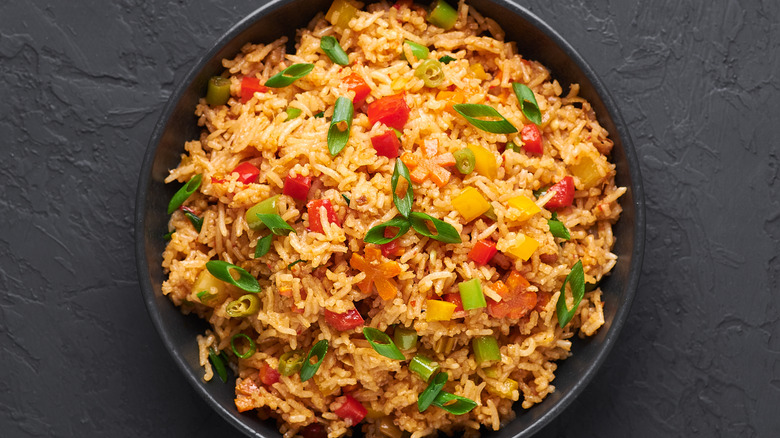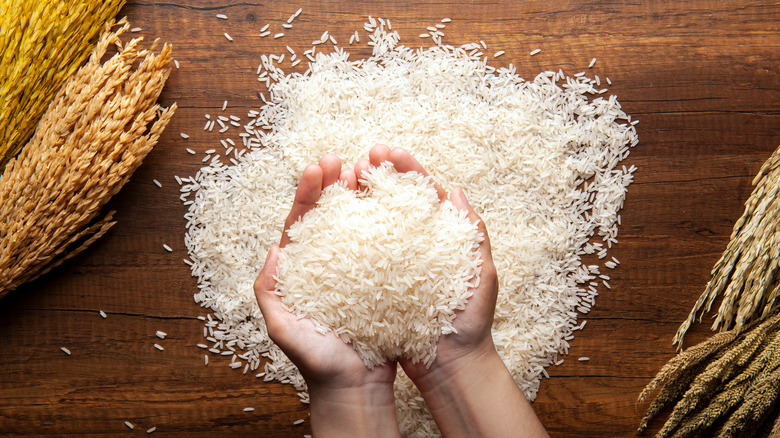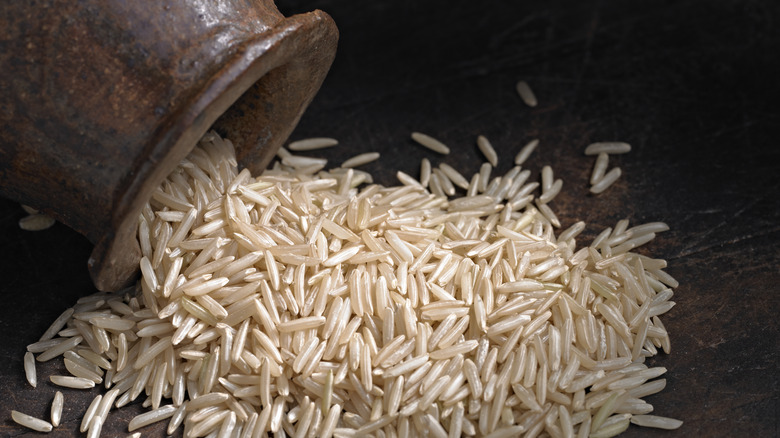The Best Rice Variety For Takeout-Worthy Fried Rice
Gone are the days of grabbing generic bags of white rice from supermarket shelves. We know a thing or two about rice subtleties, including flavor variations, aromas, texture, and which ones work best in specific rice-centric recipes. Perhaps more than anywhere else, the type of rice matters when sizzling up a pan of tasty fried rice.
From Thai versions to Japanese, Nigerian, Indonesian, Yangzhou Chinese, Spanish paella, Korean kimchi, and dozens more, the direct heat from pan-frying rice can create a mushy mess in mere minutes. That's unless you know the best kind of rice for preventing that. For takeout-worthy fried rice, you need a long-grain variety, and many chefs recommend jasmine, also called Thai jasmine or Thai fragrant rice.
A primary benefit of jasmine-based fried rice is a moderately dry texture that retains structure under high heat, allowing crispy frying without becoming overly sticky. The grains are thin and long, with a length that's roughly four times the width. It's also deliciously aromatic with a lightly sweet flavor, complementing savory ingredients in a hearty fried rice dish.
Selecting and preparing jasmine rice for fried rice dishes
It's important to note that jasmine rice comes in white or whole-grain brown forms, and less commonly, in red, purple, and black colors. It's the white jasmine rice that's typically available in mainstream markets and used in fried rice recipes. It's primarily grown in Thailand, where it's a major export, as well as in Vietnam and other Southeast Asian countries such as Laos and Cambodia.
Since fragrance is as much as 80% of what we taste in food, according to Science World, choosing the most aromatic jasmine rice can make a big difference in your fried rice recipe. Ones grown in Thailand, where the variety originated in the 1950s, are usually a good choice. They carry a fresh floral fragrance and earthy, nutty flavor, which is often compared, in Western tastebuds, to buttered popcorn.
For the most fragrant basmati rice, always choose the freshest available based on the packaging date. Though it doesn't necessarily spoil, rice that's more than several months old can lose that sensory-enhancing aroma.
How you cook the rice is crucial to obtaining the texture you want. As with most all fried rice dishes, you'll be using pre-cooked rice, and timing matters. You want it cooled for at least half an hour and separated as much as possible, rather than clumped together. Cooking it a day ahead and storing it uncovered in the fridge is even better, as it tends to get drier and more conducive to stir-frying.
The basmati option for making fried rice
Though jasmine rice has inherent qualities uniquely fitted to fried rice perfection, it's not the only long-grain option. Basmati is popular in many cultures, particularly those within India and Pakistan, the primary growing and export regions for the rice. The flavor and texture of basmati work similarly to jasmine in fried rice recipes, though some prefer it for the less sticky texture.
There's some science at play when it comes to choosing between the two. Two main starches rest within those little grains of rice, identified as amylose and amylopectin, which determine the starchy stickiness. Higher amounts of amylopectin than amylose equals stickier rice — and jasmine happens to have more of the former than basmati does. This makes some people reach for basmati to get that fluffier, firmer stir-fried rice.
Regardless of which rice you choose, it helps to remove excess starch by rinsing it before cooking. That can help provide the texture you want for stir-frying. But refrain from rinsing before it's cooked, as the grains will absorb moisture and give the exact opposite texture for your fragrant, sizzling-hot, stir-fried rice dinner.



